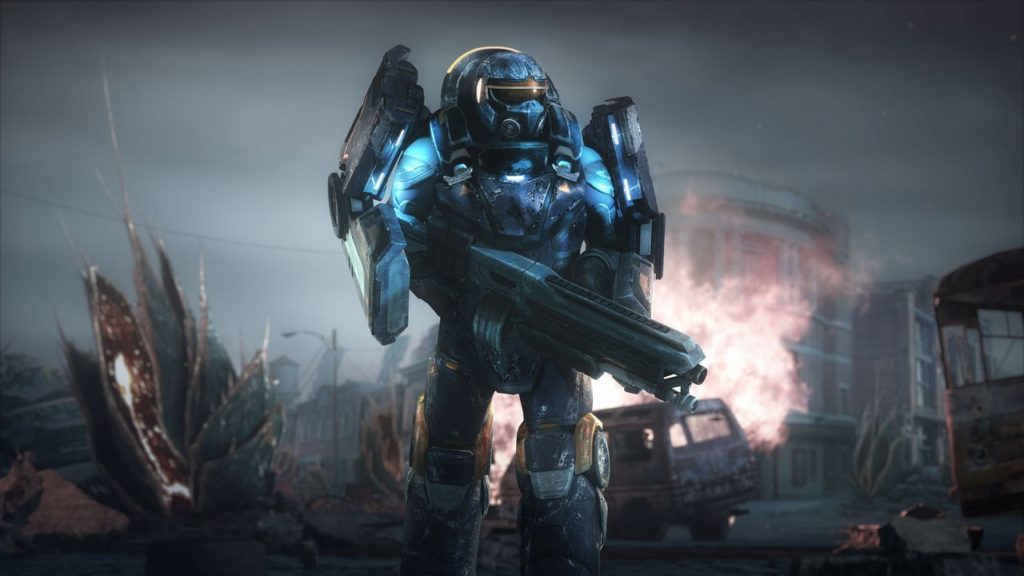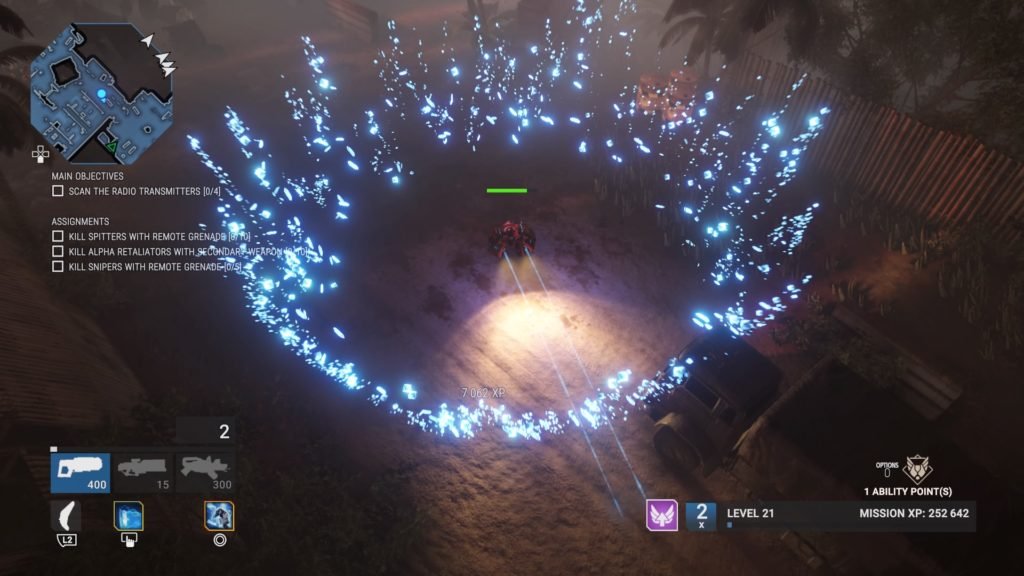Alienation review
Combining stunning visuals with an addictive gameplay loop and exceptional twin-stick shooter action, Alienation is a true joy to play.It leverages the visual flair of developer Housemarque’s previous game, Resogun, and mixes in gameplay elements from across the game’s industry. With pieces many will instantly recognize from titles like Diablo and Dark Souls, Alienation could have easily been a jumbled mess. But instead, it comes together as a stylish and incredibly crazy good time.

Combining stunning visuals with an addictive gameplay loop and exceptional twin-stick shooter action, Alienation is a true joy to play.
It leverages the visual flair of developer Housemarque’s previous game, Resogun, and mixes in gameplay elements from across the game’s industry. With pieces many will instantly recognize from titles like Diablo and Dark Souls, Alienation could have easily been a jumbled mess. But instead, it comes together as a stylish and incredibly crazy good time.
You and three other players are making your way through a small alien-overrun town in Nebraska. There’s a lot of Xenos, but with all four of you, it’s not a problem. Suddenly “Horde Approaching” flashes on the screen.
Moments later hundreds of enemies are sprinting towards you. Grenades fly. Abilities start going off. Cars begin exploding. Someone pulls out a flamethrower and lets loose as smoke and debris fills the screen. It’s complete chaotic fun. But more than that, it’s shockingly beautiful.

There are three different character classes in Alienation: the Tank, the Bio-Specialist, and the Saboteur. Each then has three character specific abilities. The Tank for instance has a ground pound, a charged super shot and can give shields to everyone in the group. Every ability is produced in bright, vibrant colors like something built from Infamous: Second Son’s neon powers. Whether it’s anything from the Tank, the Bio-Specialist’s healing, or the Saboteur’s full-screen missile barrage, each one is a visual feast.
Alienation’s name and immediate look can inspire comparisons to Housemarque’s zombie slaying Dead Nation. Those comparisons fall away however, after only about the first mission. As soon as you level up, unlock some of your characters abilities, and begin collecting loot, it becomes obvious. Alienation is the deepest, richest game Housemarque has ever made.
Before getting into the extra meat, the crowning jewel of Alienation is its moment-to-moment gameplay. As you make your way into any of the 20 missions in the game, enemies spawn everywhere and no nook or cranny is safe. Bugs burst out of cocoon-like balls, mutants rush you like fast, alien zombies, the laser sights of snipers cut across the screen, and massive goliaths shamble along, shaking the ground as they go. Each of Alienation’s dozens of enemy types act differently and are deadly in their own right. The only way to survive is through constant movement and a mix of quick reflexes and careful positioning.
Using a primary, secondary, and heavy weapon, plus an equipment slot (grenades, mines, etc.), you have to survive the seemingly endless alien hordes, fighting from one objective to the next. To help, players also have access to a dash ability, unique to each class, and a 360˚ melee. If that sounds like it’s still not quite a fair fight, that’s because it’s not. Like any good arcade twin-stick shooter, all of Alienation is built around the idea of players being constantly overwhelmed and fighting tooth and nail to survive. Simply put, every mission is anything but relaxing.
Each class has their own specific primary weapon. The Tank has a short-range, rapid fire Energy Gun, while the Bio-Specialist has a longer range, enemy-puncturing Xeno-rifle, and the Saboteur carries a ricocheting SMG. Even without considering each class’s abilities, the guns are enough to make each feel different from the start. The nice variety of other weapons and equipment keeps things from ever feeling stale. Each weapon not only feels useful, but also powerful and a blast to use.
Add in a Gears of War style active reload system, and every moment pulls you to the edge of your seat. The need to keep moving, the constant switching back and forth between weapons to deal with different threats, and timing your dashes and abilities just right becomes a frenetic dance worthy of any arcade shooter.
While Resogun, Dead Nation, and even Super Stardust before them, boasted plenty of multiplier-raising, points-chasing goodness, Alienation mixes this up. The points and score multiplier you gain by mowing down aliens don’t just count towards a leaderboard. It’s actually your character’s experience points. Dying and loosing that 5x points multiplier suddenly means a lot more than just not beating your highest score.
With each level, you receive one point to put into either your character-specific active abilities or a set of passive abilities. Points can be switched around and reallocated for free at anytime, inviting plenty of experimentation. Once you hit the level max of 30, you continue to level up in what are called Hero Levels. Each continues to up your stats while not giving any more ability points.
In case simply having the chance to take on bigger and more challenging aliens wasn’t enough, Alienation also introduces a solid helping of tempting loot. Ranging from common (grey) to legendary (orange), the loot system will make sense right off the bat to any RPG fans. Seeing a rare or legendary weapon drop keeps you coming back for “just one more mission” to try it out and maybe to get another.
But simply getting a gun is only the beginning. Using materials gained from breaking down weapons you don’t want, you can individually reroll every stat for a specific item. Once you’re happy with the base stats, then you can jump into upgrading it.
Similar to gem-slotting systems from other RPGs, Alienation’s higher-end weapons all have slots for different types of cores. Some improve damage, while others improve clip-size, fire-rate, or even critical chance. Obtained from chests, events, and just about any bigger enemies, lower cores can be combined to create better ones. From there, they can be used to upgrade your guns to your heart’s content. Though the loot and RPG systems are comparatively simple, they are intuitive and deep enough to make every mission feel rewarding.
More than once, my group and I found ourselves fighting to the complete opposite side of the huge maps, leaving our mission objectives behind. We did it to take on one of the many procedurally placed events for the chance at sweet alluring loot. And Alienation absolutely allows and rewards that type of play.
It took roughly 10 hours to get through the first playthrough, at which time I was level 15. After you finish the game once, then things get really interesting. During the second playthrough, new random events, like bosses and entire mini-dungeons, dot the maps, pulling you to venture further off your path. Also, not only are assignments, optional objectives rewarding you with crafting materials and cores, unlocked, but the game as a whole gets much harder.
While I managed many of the missions in the first playthrough on my own, the second playthrough essentially demands you team-up with other players. Thankfully, Alienation makes it a breeze with drop-in, drop-out co-op. When selecting a mission, you are shown a list of all the games set to public. If you prefer to start from the beginning of a particular mission, you can, and others will join you.
The system only falls apart as its possible to join games at any point, including just as they finish. It’s an unfortunate occurrence in an otherwise stellar multiplayer experience.
There’s no in-game voice-chat, making it that much more friendly to jump into a random game. To communicate players are given three call-outs, “Wait,” “Over Here,” and “Nice!” While “Wait” and “Over Here” serve fairly specific uses, “Nice!” ends up working triple time as a thank you, good job, and hello. Though it would have been nice to have each be an actual option, the limited number of buttons on the PS4 controller makes the choice understandable.
As far as multiplayer, there is even a Dark Souls style PvP invasion system for those that want it. At the beginning of any mission, you can select whether or not to allow invasions. Players can then see your game and jump in to hunt you down. While a nice addition for those that enjoy PvP, the option to disable the feature is definitely welcome.
And that brings us to Alienation’s endgame. After completing the second playthrough, players unlock the ability to do what are called Ark Ship missions. Drawing heavily from Diablo 3’s rift system, first UFO Access keys will drop during normal play. Using that key, players can do a UFO mission, a standard dungeon crawl with a boss at the end. That boss then has the chance of dropping an Ark Ship Access key.
Ark Ship missions are extended dungeons, asking you to kill a certain number of enemies in order to unlock the door to a big boss. Timed and scored, Ark Ship runs have their own leaderboards. While offering awesome loot, leaderboard climbing or trophy chasing comes off as a muted note at the end of a rock solid game.
You can easily start a new character, but cores and crafting materials aren’t account wide. You will be starting from the ground up once more, regardless of your first character.
While my time with Alienation did see a few game crashes, the multiplayer was stable and easy to use. Despite being tied together with a sadly forgettable story, the 20 story missions are fun and packed with action. And even if the endgame is nothing exceptional, the general gameplay is absolutely on point.
For players that really do want a solo experience, the increase in difficulty may make that hard to continue beyond the first playthrough. But for those that open up to the hectic chaos of four players blasting away at aliens like there’s not tomorrow, there’s an awesome game waiting for you to sink your teeth into.
